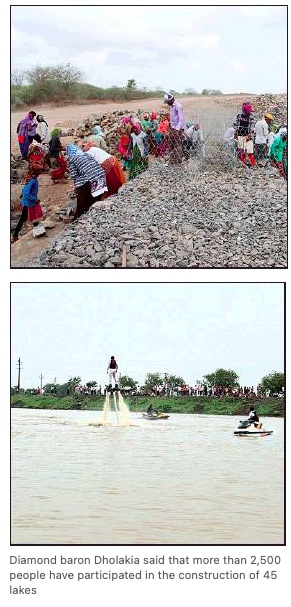Savji Dholakia/ Hari Krishna Diamonds
This is a collection of articles archived for the excellence of their content. |
Creating lakes
As in 2019
Himansshu Bhatt & Melvyn Reggie Thomas, August 4, 2019: The Times of India

From: Himansshu Bhatt & Melvyn Reggie Thomas, August 4, 2019: The Times of India
Diamond baron from Surat leaves sparkling water legacy
Surat:
They say diamonds are a woman’s best friend, but it wasn’t a shining stone that Savji Dholakia’s mother wanted. All she ever prayed for was a little rain.
Many years ago, in diamond baron Dholakia’s native Dudhala in Amreli district (Gujarat), children’s education would take a back seat as villages reeled from long dry spells, rain-fed agriculture their sole mainstay. Erratic rains led to crop failure and hardship. Young Savji, too, was forced to quit his studies and move to Surat for a livelihood where he went on to script a glittering ragsto-riches story.
The 57-year-old owner of a Rs 6,000-crore diamond empire never forgot his mother’s prayers or his childhood plagued by perennial water crisis, a problem that persists in Amreli.
The promoter of Hari Krishna Diamonds hit headlines in 2015 when news spread that he had gifted cars and flats to his employees, but his Dholakia Foundation over the last two years has worked on a more lasting legacy. It has helped build or deepen 45 lakes in his birthplace Dudhala and 22 more waterscarce villages of Amreli. Dholakia says his target is to build 70 lakes. “It is time to repay my native place,” the diamond baron said, adding, “25 lakes will be constructed in the next year.”
Talking about turning drought-ridden villages water resilient, Dholakia said, “I had donated Rs 33 lakh to a private trust for rainwater harvesting in Saurashtra 15 years ago. But then I felt it would be better to make a lake in a village to meet the needs of people and farmers. So I took on the task of building five small lakes in Dudhala, spending Rs 1.5 crore.”
Work on a 400-acre sprawl in Dudhala was started by digging 15-20 feet deep into the dry bed of a creek called Gagario, a couple of kilometres from the Shetrunji river, the second major river in Saurashtra, which flows into the Arabian Sea. Water from Shetrunji was then diverted into Gagario, filling up the 400 acres, which has become a source of water to nearly 25 villages in areas surrounding Dudhala.
Dholakia Foundation goes village to village, encouraging local residents to partner in “lake development work”. The foundation pays Rs 25 lakh to each panchayat for machinery, expertise and wages. Villages decide whether they want one large water body or a couple of smaller reservoirs.
“More than 2,500 people have participated in construction of the 45 lakes in our villages,” said Dholakia. For the makers of lakes, it is heartening to see “small lakes of an acre or two fill up early monsoon, the water lasting several months”.
‘This has ended villagers’ long trudge to get daily water,” said Bharat Der of Lathi village. ‘It has also helped farmers take two crops a year. Dependence on monsoon has far reduced.”
Trupti Sonara, a government geologist, said, “Storage of water in lakes helped recharge groundwater in these villages. While digging the lakes, they took care to remove soil from the upper layer, which is impervious. As a result, underground seepage of water is very good.”
Nandlal Nakrani, a farmer from Ganeshgadh village, said, “You dig up anywhere and you will find water at 30 feet, thanks to the huge lake constructed in our village two years ago.” It is the lasting treasure the villages need.